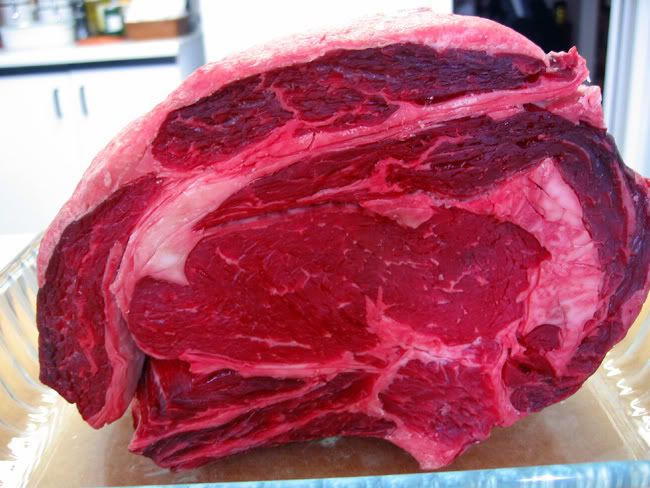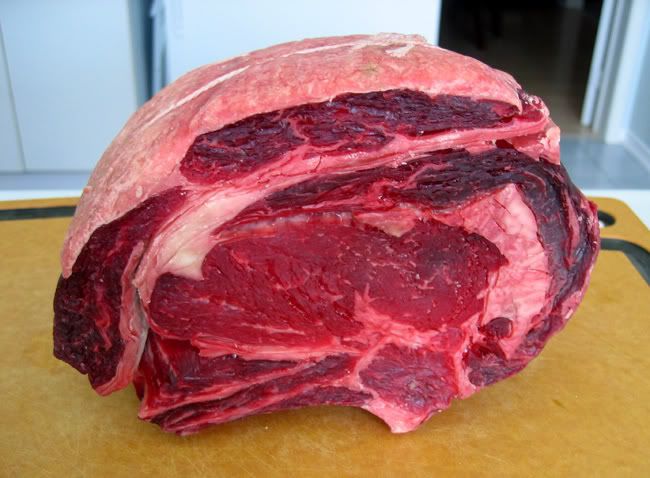I love the smell of rot in the morning...
It smells like, victory....

Dry aging meat is something that top restaurants around the world will do. Usually this process must occur in very controlled conditions of temperature and humidity as to ensure proper aging. After all, the meat is just being allowed to rot. I love food, I'm also daring with what I eat and how I experiment. In short, I dry aged a standing rib roast in my home refrigerator.
Dry aging is a timely process. As the meat is allowed to age it dries out and loses moisture, this concentrates the beef flavour. A downside to this is that the loss in weight (from the lost water) increases the cost of the meat. Also, enzymes within the meat break downs the muscle tissues and results in a tenderer piece of meat.
I love roast beef, specifically, I love standing rib roasts. I refuse to call a standing rib roast, "prime rib" unless the beef has come cut from USDA certified Prime beef. If I called every rib roast as prime rib then I may as well call canned tuna "sushi grade tuna". They're two completely different things. Great beef is something special and something to be appreciated. Cooking a rib roast can be simple but for great results you need to begin with great beef, this is what the experiment was about.
I purchased a Canadian AA grade rib roast that weighed about 3 kg. I aged it in my fridge for 6 days and took photos every 48 hours to document that aging process and how it transformed the cut of meat. At the end of the process I trimmed the meat of leathery and dark portions as well as trimming a thin layer of dried out fat from the cap.
 48 hours
48 hours 4 days
4 days 6 days
6 days Trim
TrimI seasoned the roast with kosher salt and fresh cracked black pepper. I begin the roasting process at a high temperature to sear the meat and then lower the temperature to continue roast. The exact process is 450F for 15 minutes and then lowered to 300F and continue roasting for 15 minutes per pound. I actually learned this technique from the Chef at Home cooking show, this method has never failed me.
Cooking the roast was tricky due to the fact that it had lost water weight from drying out. I estimated that it lost at least 1.5 lbs and cooked it as if it were 5 lbs. Towards the last half hour of roasting I probed the meat using an instant read thermometer to ensure proper degree of doneness.
Cooking the roast was tricky due to the fact that it had lost water weight from drying out. I estimated that it lost at least 1.5 lbs and cooked it as if it were 5 lbs. Towards the last half hour of roasting I probed the meat using an instant read thermometer to ensure proper degree of doneness.
Appearance: Medium-Rare beef. Red meat through the cut that dulls in colour towards the edges indicated a higher degree of doneness.
Aroma: Strong beef aroma. Most noticeable upon the first slice in the beef. Fat portions also had stronger beef aroma that expected.
Flavour: Stronger beef flavour in the portions closer to the exterior cut of the meat.
Texture: Tender meat. Most tender portions were those closer to the exterior of the meat. Well done portions were surprisingly tender, having a consistency typical of braised meats.
This experiment was worth it. Next time I want to do it for twice as long and with a better cut of beef. I'll up the ante from AA grade to AAA.
Aroma: Strong beef aroma. Most noticeable upon the first slice in the beef. Fat portions also had stronger beef aroma that expected.
Flavour: Stronger beef flavour in the portions closer to the exterior cut of the meat.
Texture: Tender meat. Most tender portions were those closer to the exterior of the meat. Well done portions were surprisingly tender, having a consistency typical of braised meats.
This experiment was worth it. Next time I want to do it for twice as long and with a better cut of beef. I'll up the ante from AA grade to AAA.




1 comments:
Genial brief and this mail helped me alot in my college assignement. Thank you seeking your information.
Post a Comment